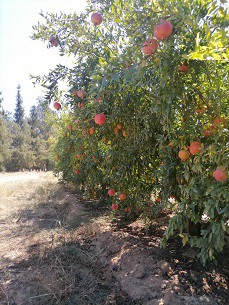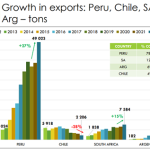The pomegranate farmers in the Western Cape districts of Wellington, Paarl and the Swartland are completing their harvests following a year that, as with many other seasons – came two weeks ahead of schedule this year. Initially , the crop was thought to be less hefty, however some farmers in the Cape have been able to confirm comparable or bigger crops Kai-Uwe Mozahn, newly appointed chairman of POMASA and POMASA, which is the South African growers’ organisation to export pomegranate.
A significant increase in pomegranate exports coming from Peru’s Southern Hemisphere, where Peru remains a far cry from other regions of production (source Hortgro)
A late end can be beneficial since it boosts the likelihood of being in Europe prior to Peru or heading across in the Middle East ahead of Eid that falls on the 21st of April.
 “The problem is that we’re having a hard time in shipping. The year before and before , shipping was poor and does not appear to be getting much better this year.” Kai-Uwe Mozahn who started the pomegranates in Wijdgezicht Farm on what used to be vineyards.
“The problem is that we’re having a hard time in shipping. The year before and before , shipping was poor and does not appear to be getting much better this year.” Kai-Uwe Mozahn who started the pomegranates in Wijdgezicht Farm on what used to be vineyards.
The pomegranate is sold through Sapex.
“The Middle East has been our largest growth market in the past couple of years, and even today South Africa sends more than 50 percent of its pomegranates Middle East countries. Middle East. In the meantime, our European market has decreased but not by volume, but rather in terms of proportions. It’s the Middle East has grown tremendously for us , and is an extremely important market to us.”
The market from Middle East countries Middle East understand the fruit more than markets that focus on its appearance. The appearance of blemishes, scratches and sunburn don’t affect the aril’s quality, however this fruit is generally shipped as processing grade particularly in regions like the Middle East where it probably will not be processed however, but to pomegranate-loving households.
This year’s exports of pomegranate of South Africa was 15% more than the year before and included 1.995 millions 3.8kg boxes (roughly two-thirds of which were processed) which is a significant increase in the last decade.
“The European market has shrunk however, not necessarily in terms of volume, but rather in terms of percent. In terms of percentages, the Middle East has grown tremendously for us and is an extremely important market that we are able to tap.” (graph: PPECB/Hortgro)
Changes in irrigation timing as the harvest draws near
“Although there was more unusual rain in February and in March (for each month there was nearly 100mm in my area in Riebeeck-Kasteel, just outside of the city) I’ve got better-quality the pomegranates I’ve seen this year. There isn’t the same amount of waste due to cracks in the fruits this year. This is usually a result of rain that is early and this year we experienced the early rain. I believe that if you are anticipating the possibility, you will be able to counter the issue by utilizing your irrigation methods,” Kai-Uwe says.
Based on the advice from an irrigation expert whom he consulted following massive damages to cracks over the past two seasons, he altered the timing of irrigation closer to harvest , to ensure that the swelling of the arils won’t force, or break, and the more hardened peel.
The subject of irrigation instantly reminds us of another issue the ongoing power outages.
“The second challenge we face to us all is the massive loadshedding that during the months of January, December and February, which was extremely problematic for us since it decided the amount of irrigation could be applied. The ability to stick to an irrigation plan that requires up to 12 hours of loadshedding can be very challenging.”
The company has made a significant effect on this part of the industry, according to him.
“Loadshedding has been improving in the past week or two however, it’s now towards the close of the season, and we’ve stopped all irrigating aside from some post harvest finalization requirements.”
The expansion of pomegranates is occurring in the north of South Africa
The author notes that there have many freshmen to pomegranate farming in Limpopo Province. POMASA is now a part of a group comprised of around 70 cultivators.
“They are about two or three weeks later than Western Cape and that gives an industry market access earlier during the time of. This gives us an opportunity to get our chance to get our foot on the ground and that’s great for us. It provides South Africa a longer span which can range between six and seven weeks, to between eight and nine weeks in the present. North-facing growers are able to be competitive with Peru regarding timing. They could begin in the early or in the two weeks of year .”
Pomegranates that are grown in northern Africa to export was transported to the packline for packing within the Western Cape, but a north-facing pomegranate farmer has changed his packline of citrus to pomegranates.
POMASA recently elected a director to its board of POMASA located in northern regions for better representation of producers in the north.
Industries have developed organically
They haven’t experienced the growth (and bust) of their peers similar to lemons.
“The development of the pomegranate crop is more organic and there haven’t been too many producers of pomegranate disappearing. Some producers may switch over from specific cultivars such as Herskovits to Wonderful, or even a different variety,” the expert says.
“Also it isn’t common for farmers to cultivate pomegranates solely for their own benefit. They’re typically in the context of the wine grapes and table grapes that are grown within this zone as well as soft citrus or Apricots.”
In northern regions, some landmass of potatoes have been turned into the cultivation of pomegranates.
POMASA recently finished an international market study that analyzed market priority, to discover alternatives and new markets for the business.
 For further information:
For further information:
Kai-Uwe Molzahn
POMASA
Tel: +27 21 870 2900
Email: andriette@hortgro.co.za
https://www.sapomegranate.co.za/
